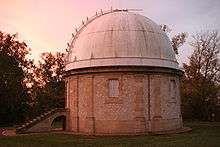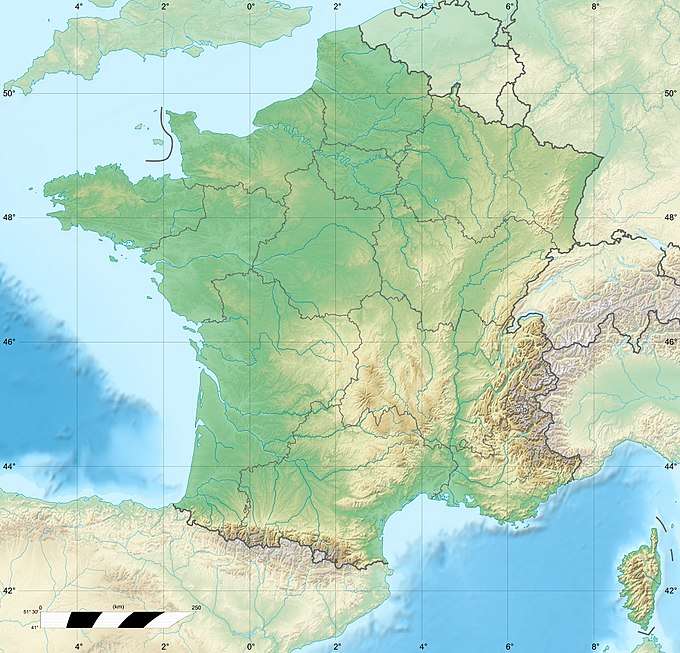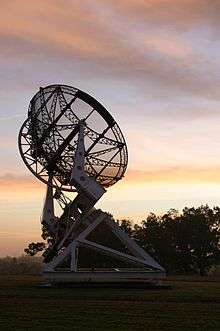Bordeaux Observatory
The Bordeaux Observatory is an astronomical observatory affiliated with the University of Bordeaux. Built in Floirac, France in 1893 its lenses were focused between +11 and +17 degrees declination. Until 1970 it had taken over 4,000 photographic plates.[1][2] Bordeaux Observatory is home to a large collection of instruments and archives from well over a century of astronomical activities.[3] Until the 2016 it was actively used until the institution moved to a new location at the University.[4] In the French language the name is Observatoire de Bordeaux.[5]
 The dome of the "Grand équatorial" at Bordeaux Observatory, 2006 | |
| Observatory code | 999 |
|---|---|
| Location | Floirac, France |
| Coordinates | 44°50′06″N 0°31′34″W |
| Established | 1877 |
| Closed | 2016 |
| Telescopes | Bordeaux observatory würzburg radar |
 Location of Bordeaux Observatory | |

Early history
In the late 18th century an attempt to establish Bordeaux Observatory wad made after the transit of Venus.[6] This led to a house being set aside as the Bordeaux Observatory, however, it was not equipped with any instruments.[6] Although it did not really get established, it carried the banner of desire for real observatory in the area for a century.[6] Finally, in 1876 an agreement between Government and the city was reached to establish a real observatory.[6] The Government was trying to execute on a national agenda of increased education, and this nexused with city's desire for an Observatory; Bordeaxu would contribute 100,000 francs for its founding.[6]
It was founded in 1879 on a hill overlooking the Garonne river.[7]
The Bordeaux observatory was established in the late 1870s, and one of its first instruments was a Meridian circle.[8] The instrument was built by Eichens with and glass objective of 19 cm by Henry.[6] Also, an equatorial mounted refractor (glass lens) with 38 cm lens.[6] The objective lens was made by Merz, and the mounting was done by Gautier and Eichens.[6] Also a 13-inch (32 cm) aperture astrograph in support of the Carte du Ceil project.[9]
On founding, the observatory had the following areas of study:[6]
- Magnetic and meteorological observations
- Meridian observations—this had to do mostly with star positions)
- Equatorial observations— observations with the telescopes such as of comets, asteroids, moons of the Solar system, and stars
- Computations — such as for publications of meteorological catalogs
Early work with the Meridian included updates to the Argelander-Öltzen star catalog.[6]
1900s
In the late 20th century Bordeaux Observatory became active in field of radio astronomy.[10] In 1967 the construction of millimeter wave interferometer was begun, in conjunction with others.[10]
Between 1983 and 1988, the automatic meridian circle of Bordeaux Observatory was used in support of the Hipparcos space observatory.[11] The success of that space mission was on factor leading to demise of the utility of automatic meridian circles, because of the extreme accuracy achieved by Hipparcos for that time period.[11]
In 1990 a microwave radiometer for measuring ozone was established at the Observatory.[12]
In 1999, Bordeaux Observatory became a site for IVS.[13]
2000s
In early 21st century it remained the site for the Laboratoire d'Astrophysique of Bordeaux, but that institution planned to move out from the site.[3]
In 2016, an astronomer of Bordeaux Observatory noted on a possible formation mechanism for "Planet Nine", a hypothesized planet beyond the Kuiper belt in the 2010s.[14] In a simulation of solar system formation, they suggested that it could be leftover building block of an earlier time.[14]
As an institution the Bordeaux Observatory became the Observatoire Aquitain des Sciences de l’Univers (OASU).[4] In 2016, the staff moved from Floirac facilities to a new building at the University of Bordeaux in Pessac.[4]
See also
References
- The Bordeaux Observatory
- "Les Collections Patrimoniales de l'Observatoire Astronomique de Bordeaux". Laboratoire d'Astrophysique de Bordeaux (in French). Archived from the original on 4 March 2016. Retrieved 1 October 2015.
- de La Noë, J.; Charlot, P.; Grousset, F. (2009-11-00). "Property and instrumental heritage of the Bordeaux Astronomical Observatory; What future?". SF2A-2009: Proceedings of the Annual Meeting of the French Society of Astronomy and Astrophysics: 343. Bibcode:2009sf2a.conf..343D. Check date values in:
|date=(help) - "Report for 2015–2016 from the Bordeaux IVS Analysis Cente" (PDF).
- Limited, Addison-Wesley Longman; Limited, Cartermill International; Longman (Firm) (1993). Earth and astronomical sciences research centres: a world directory of organizations and programmes. Longman. ISBN 9780582229648.
- Observatory, United States Naval (1889). Astronomical, Magnetic and Meteorological Observations Made at the United States Naval Observatory. U.S. Government Printing Office.
- "Observatories – Bordeaux". promenade.imcce.fr. Retrieved 13 November 2019.
- Hutchins, Roger (2008). British University Observatories, 1772–1939. Ashgate Publishing, Ltd. ISBN 9780754632504.
- Hutchins, Roger (2 March 2017). British University Observatories 1772–1939. Routledge. ISBN 9781351954525.
- Leverington, David (2017). Observatories and Telescopes of Modern Times. Cambridge University Press. ISBN 9780521899932.
- Oswalt, Terry D. (2003). The Future of Small Telescopes in the New Millennium: The telescopes we use. Kluwer Academic Publishers. ISBN 9781402009495.
- Science, International Union of Radio (1990). Digest. Institute of Electrical and Electronics Engineers.
- Charlot, P.; Bellanger, A.; Bourda, G.; Camargo, J. I. B.; Collioud, A.; Baudry, Alain (2006). "The Bordeaux Observatory IVS Analysis Center: Current Activities and Future Plans". Semaine de l'Astrophysique Française, Paris (France), June 26–30, 2006. Paris, France: 53.
- Grossman, Jacob Aron, Adam Becker and Lisa. "How Planet Nine may have been exiled to solar system's edge". New Scientist. Retrieved 17 February 2020.
External links
| Wikimedia Commons has media related to Bordeaux Observatory. |